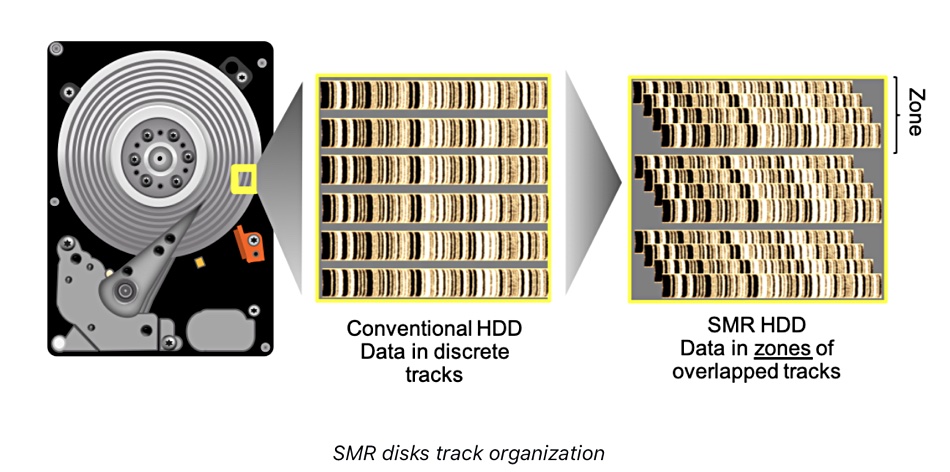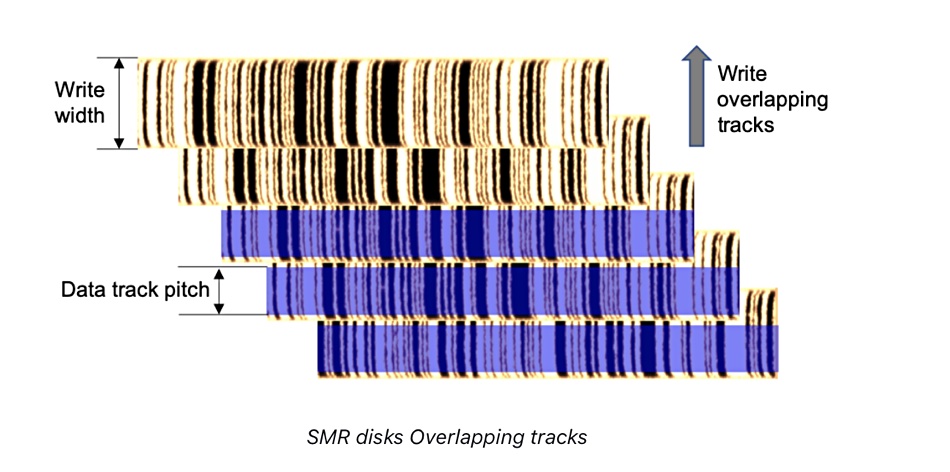Western Digital published a blog earlier this week that suggests users who are experiencing problems with their WD Red NAS SMR drives may be over-using the devices. The unsigned article suggests they should consider more expensive alternatives.
WD said it regretted any misunderstanding: “WD Red HDDs are ideal for home and small businesses using NAS systems. They are great for sharing and backing up files using one to eight drive bays and for a workload rate of 180 TB a year. We’ve rigorously tested this type of use and have been validated by the major NAS providers.”

Western Digital Shingled Magnetic Recording diagramThe WD blog contains two paragraphs about perfomance:
“WD Red HDDs are ideal for home and small businesses using NAS systems. They are great for sharing and backing up files using one to eight drive bays and for a workload rate of 180 TB a year. We’ve rigorously tested this type of use and have been validated by the major NAS providers.”
The second paragraph explains: “The data intensity of typical small business/home NAS workloads is intermittent, leaving sufficient idle time for DMSMR drives to perform background data management tasks as needed and continue an optimal performance experience for users.”
WD suggests: “If you are encountering performance that is not what you expected, please consider our products designed for intensive workloads. These may include our WD Red Pro or WD Gold drives, or perhaps an Ultrastar drive. Our customer care team is ready to help and can also determine which product might be best for you.”
Defining moments
We think that the WD Red NAS SMR drives are not ideal for customers experiencing problems. The workload rate number – 180TB written per year ignores the need for an intermittent workload leaving sufficient idle time for background data management.

We also think that terms used by WD are not defined. For example:
- What is data intensity?
- What does a “typical small business/home NAS workload” mean? Apart from workload up to 180TB/year.
- What does “intermittent” mean? Does it mean X minutes active followed by Y minutes inactive? What are X and Y?
- What does “sufficient idle time” mean? Does it mean Z minutes per hour? What is ZX?
This woolliness makes it difficult to understand if a WD Red NAS SMR drive is suited to a particular workload or not.
The trade-off for HDD vendors
We asked Chris Evans, a data storage architect based in the UK, what he thought about WD’s blog. We publish his response below:

“With any persistent storage medium, we are at the mercy of how that technology is implemented. The trade-off for HDD vendors has been in making products capable of ever-increasing capacities while continuing to deliver reliability. Almost all the new techniques used in HDD capacity gains have a side effect.
“A few years ago, for example, HDDs started to get rate limits quoted – this wasn’t explicitly mentioned in product specifications, but obviously needed to be added as a warranty restriction because drives couldn’t write 24×7 with some of the latest technologies.
“SMR represents a significant challenge (I wrote about it recently here – https://www.architecting.it/blog/managing-massive-media/) to the extent that WD’s own website (zonedstorage.io) references drive-managed SMR as having “highly unpredictable device performance”.
That WD website, dated 2019, states: “Drive Managed disks are suitable for applications that have idle time for the drive to perform background tasks such as moving the data around. Examples of appropriate applications include client PC use and external backup HDDs in the client space.”
Evans continues: “I would expect in this circumstance that all HDD manufacturers explain when and how they are using SMR. It could be that SMR is used as a background task, so drives can cope with a limited amount of sustained write I/O, after which the performance cliff is hit and the drive has to drop to a consolidation mode to restack the SMR data. Customers would then at least know if they purchased SMR technology, that some degree of performance impact would be inevitable.
“Whilst HDD vendors want to increase capacity and reduce costs (the $/GB equation is probably the only game in town for HDDs these days), a little transparency would be good. Tell us when impactful technology is being used so customers can anticipate the challenges – and of course appliance and SDS vendors can accommodate for this in their software updates.”







